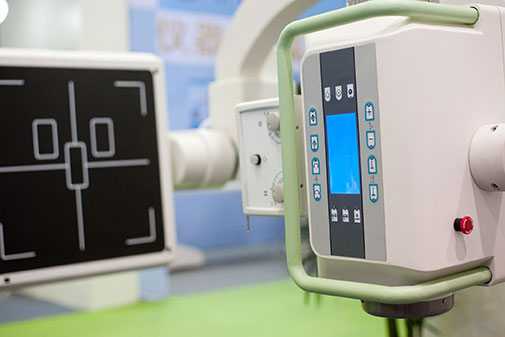Radiation in Medicine - Fluoroscopy
Fluoroscopy is a medical imaging test that uses an x-ray beam that passes continuously through the body to create an image. The image is projected on a monitor which allows doctors to see the movement of internal organs in real-time.
Medical imaging procedures such as fluoroscopy play a valuable role in preventing health problems and diagnosing diseases. During a hospital stay or outpatient procedures your doctor may request that you undergo fluoroscopy to determine treatment procedures for a particular health concern. Fluoroscopy procedures involve exposure to ionizing radiation, which can present risks. However, if patients understand the benefits and risks they can make the best decisions about their health care.
What are some common medical imaging tests that use ionizing radiation?
Most people have had one or more medical imaging tests that use ionizing radiation. The type of imaging procedure that your doctor may suggest will depend on your health concern and the part of the body that is being examined. Some other common examples of imaging tests include:
- X-rays (including dental x-rays, chest x-rays, spine x-rays)
- CT or CAT (computed tomography) scan
If your doctor suggests x-rays or other medical imaging procedures you should consider the following:
- Medical imaging tests should be performed only when necessary.
- The U.S. Food and Drug Administration (FDA) recommends discussing the benefits and risks of fluoroscopy with your doctor.
What happens during a fluoroscopy procedure?

Before the procedure
Ask your health care provider to explain the procedure and make sure you ask him/her if you still have additional questions. Some fluoroscopy procedures may use a “contrast dye” which allows doctors to see specific organ(s). The dye may be administered by swallowing, an intravenous (IV) line in your hand or arm, or an enema.
Make sure to let the doctor know if:
- You have ever had a reaction to any contrast dye.
- You are pregnant or suspect that you may be pregnant.
During the procedure
- You will be asked to remove any clothing and jewelry that may interfere with the procedure.
- You will be positioned on the x-ray table, and depending on the type of procedure, you may be asked to do the following: assume different positions, move a specific body part, or hold your breath at intervals while the fluoroscopy is being performed.
- A special x-ray machine will produce fluoroscopic views of the body structure being examined or treated.
What are the benefits and risks of fluoroscopy?
Medical imaging tests such as fluoroscopy are non-invasive procedures that allow doctors to diagnose diseases and injuries.
These tests can help doctors:
- Obtain a better view of organs, blood vessels, tissues and bones
- Determine whether surgery is a good treatment option
- Guide medical procedures involving placement of catheters, stents, or other devices inside the body, locate tumors for treatment and locate blood clots or other blockages
- Guide joint replacement options and treatment for fractures
As in many areas of medicine, there are risks associated with the use of fluoroscopy, which uses ionizing radiation to generate images of the body. Risks from exposure to ionizing radiation include:
- A small increase in the likelihood that a person exposed to radiation will develop cancer later in life.
- Health effects that could occur after a large exposure to ionizing radiation such as acute skin reddening, and hair loss.
- Possible allergic reactions associated with a contrast dye injected intravenously into the veins to better see body structures being examined.
While fluoroscopy itself is not painful, the particular procedure being performed may be painful, such as the injection into a joint or accessing of an artery or vein for angiography. In these cases, the radiologist will take all comfort measures possible, which could include local anesthesia, conscious sedation, or general anesthesia, depending on the particular procedure.
How can you reduce your exposure to diagnostic ionizing radiation?
In the case of x-rays or other tests involving exposure to ionizing radiation, doctors and radiation experts can help reduce your exposure to and risk of harm from diagnostic ionizing radiation by:
- Checking to see if you have had a similar test done recently that can provide them with the background information they need.
- Checking to see if a test that does not use ionizing radiation can provide similar information.
- Making certain the least possible amount of radiation needed to obtain a good quality image is used for your procedure.
- Providing protective lead shielding to prevent exposing other areas of the body to radiation.
Radiation experts include the following:
- Hospital radiation safety officer
- Medical physicist
- Radiation physicist
- Diagnostic medical physicist
What are the risks of medical imaging procedures for pregnant women?
Talk to your physician about the potential risks and benefits from the medical procedures. In many cases, the risk of an x-ray procedure to the mother and the unborn child is very small compared to the benefit of finding out about the medical condition of the mother or the child.
Many doctors use ultrasound to examine the abdomen, pelvic area, or heart. Ultrasound does not use ionizing radiation, so it does not expose women of childbearing age to radiation in the pelvic area. This is particularly important in pregnancy. For more information, please see the Image Wisely website.
Risks that are considered small should not be taken if they’re unnecessary. You can reduce risks from medical imaging procedures by telling your doctor if you are, or think you might be, pregnant whenever an abdominal x-ray is suggested by your doctor. Other options suggested by FDA that may be considered are as follows:
- If you are pregnant, the doctor may decide that it would be best to cancel the medical imaging procedure, to postpone it, or to modify it to reduce the amount of radiation.
- Depending on your medical needs, and realizing that the risk is very small, the doctor may feel that it is best to proceed with using a medical imaging procedure as planned.
In any case, you should feel free to discuss the decision with your doctor. For more information on medical imaging and pregnancy, please see X-rays, Pregnancy and You. Also, for more information on radiation safety in adult medical imaging, please visit the Image Wisely website.
Are there special considerations for children?

It is important that x-rays and other medical imaging procedures performed on children use the lowest exposure setting needed to obtain a good quality image. The Image Gently Alliance, part of the Alliance for Radiation in Pediatric Imaging, suggests the following for imaging of children:
- Use imaging examinations when the medical benefit outweighs the risk.
- Use the most appropriate imaging techniques, matched to the size of the child.
- Use alternative imaging methods (such as ultrasound or MRI) when possible.
The U.S. Food and Drug Administration (FDA) also provides information for parents, patients and healthcare providers to address concerns about the benefits and risks of medical imaging procedures for children.
Are there medical imaging tests that do not use ionizing radiation?
There are also medical imaging procedures such as Magnetic Resonance Imaging (MRI) or ultrasound that do not use ionizing radiation to diagnose illnesses or injuries.
What is Magnetic Resonance Imaging (MRI)?
MRI procedures, which can lasts from 30-60 minutes, use magnetic fields and radio waves to produce images of specific parts of the body. MRI scans are often performed along with other medical imaging procedures to provide a more detailed view of the area of the body that is being examined. For more information on MRI, please see FDA’s website on MRI (Magnetic Resonance Imaging).
What is an Ultrasound?
Ultrasound imaging uses high-frequency sound waves to see inside the body. There is no ionizing radiation used and in most ultrasound examinations, no contrast is given.
Related Links
FDA
- Reducing Radiation from Medical X-rays
- Pediatric X-ray Imaging
- Radiology and Children: Extra Care Required
- X-Rays, Pregnancy and You
- Medical X-rays: How Much Radiation are You Getting
Image Gently
EPA
- RadTown USA Medical X-Rays
- Radiation Protection Guidance for Diagnostic and Interventional X-Ray Procedures
US National Library of Medicine
- Page last reviewed: November 8, 2016
- Page last updated: November 8, 2016
- Content source:


 ShareCompartir
ShareCompartir